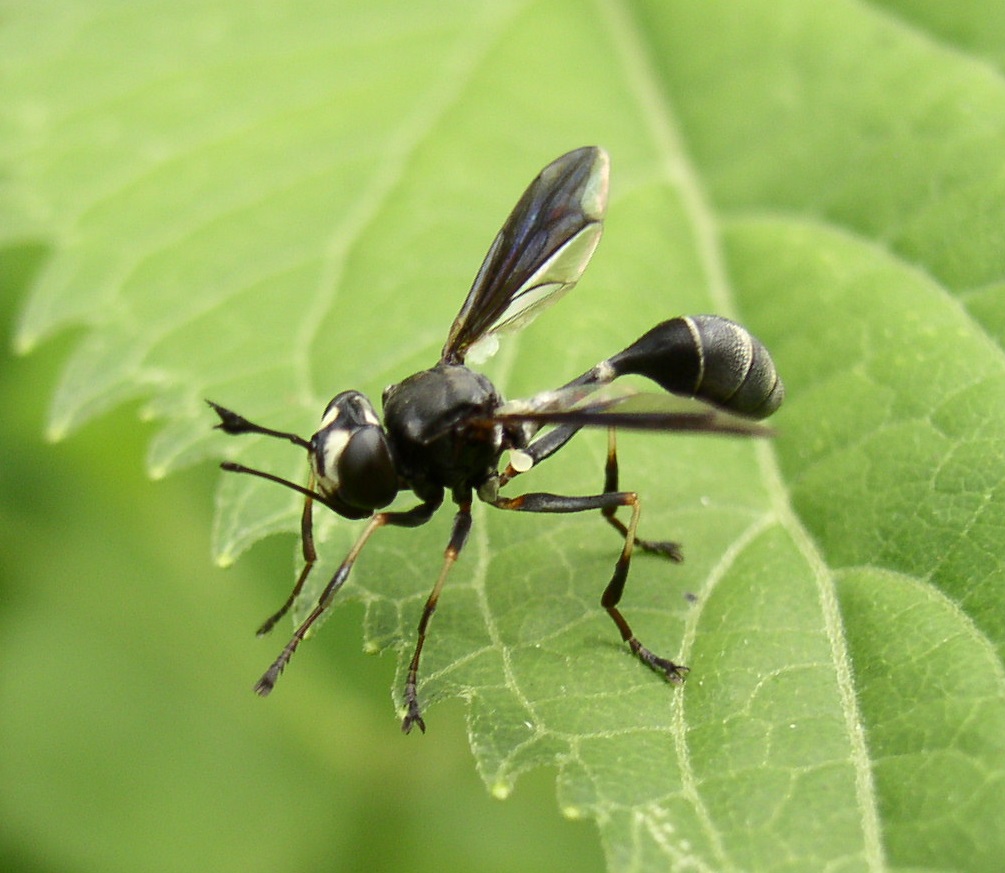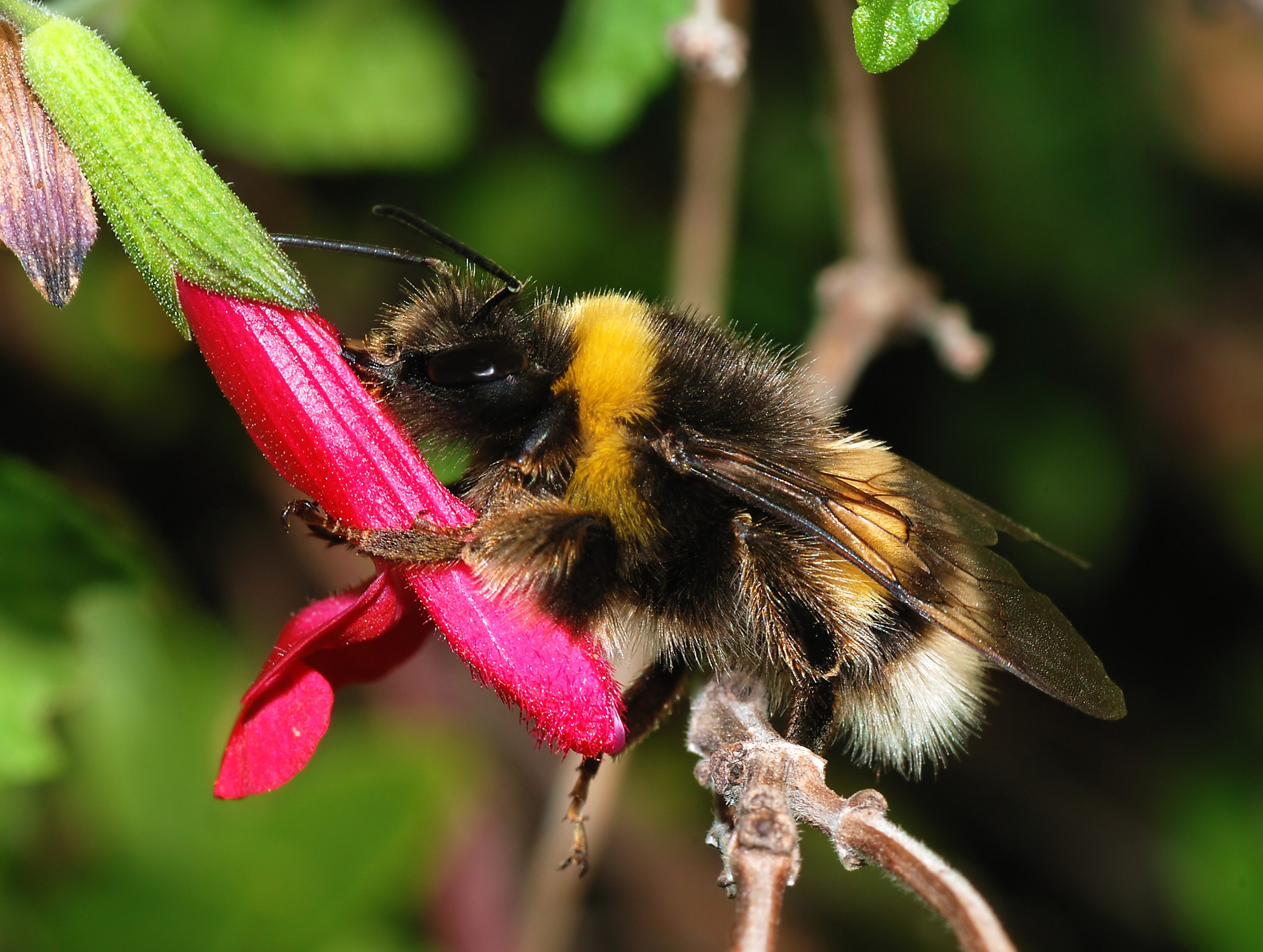Physocephala tibialis on:
[Wikipedia]
[Google]
[Amazon]
''Physocephala tibialis'' is a species of

 ''P. tibialis'' females can often be found near the base of flowering plants anticipating the arrival of host species. The females attack hosts during foraging periods and insert an egg into their abdomen. The female penetrates an intersegmental membrane on the host in order to gain access to the abdominal cavity.
''P. tibialis'' females can often be found near the base of flowering plants anticipating the arrival of host species. The females attack hosts during foraging periods and insert an egg into their abdomen. The female penetrates an intersegmental membrane on the host in order to gain access to the abdominal cavity.
 Different species of bee respond differently to being infected by P.tibialis. Almost 70% of common eastern
Different species of bee respond differently to being infected by P.tibialis. Almost 70% of common eastern
thick-headed fly
The Conopidae, usually known as the thick-headed flies, are a family of flies within the Brachycera suborder of Diptera, and the sole member of the superfamily Conopoidea. Flies of the family Conopidae are distributed worldwide in all the biog ...
(family Conopidae
The Conopidae, usually known as the thick-headed flies, are a family of flies within the Brachycera suborder of Diptera, and the sole member of the superfamily Conopoidea. Flies of the family Conopidae are distributed worldwide in all the biog ...
) found throughout the eastern United States, often near flowering plants. The adult fly is primarily black with a yellow face and thin white stripes on the abdomen. It is commonly found along the east coast of the United States and is often found near flowering plants.
''P. tibialis'' flies parasitize many different species of bees by laying their eggs inside the abdomen of their host. The larva
A larva (; plural larvae ) is a distinct juvenile form many animals undergo before metamorphosis into adults. Animals with indirect development such as insects, amphibians, or cnidarians typically have a larval phase of their life cycle.
The ...
hatches inside of the host and grows and develops until it takes up the majority of the host's abdomen. The host then dies and the larva envelopes itself in a puparium and pupa
A pupa ( la, pupa, "doll"; plural: ''pupae'') is the life stage of some insects undergoing transformation between immature and mature stages. Insects that go through a pupal stage are holometabolous: they go through four distinct stages in their ...
tes inside of the corpse. After an extended period of pupation, the adult emerges from the corpse of the host bee. When a bee becomes parasitized by a ''P. tibialis'' larva, certain behaviors such as induced grave digging and changes in flower preference often occur.
Geographic distribution
''P. tibialis'' is found in North America, primarily along the east coast of the United States. They can be seen as far north as Massachusetts and as south as Florida. They have also been seen as far west as Wisconsin and Texas.Habitat
''P. tibialis'' can often be found near flowering plants, likely due to the presence of host speciespollinating
Pollination is the transfer of pollen from an anther of a plant to the stigma of a plant, later enabling fertilisation and the production of seeds, most often by an animal or by wind. Pollinating agents can be animals such as insects, birds, a ...
nearby plants. They have not been seen to prefer specific species of plants, and attack host species at a variety of different flowering plants.
Physical description
Larva/pupa
The larva is white and swollen when it hatches from the egg and molts three times until it reaches its fully grown size of around 30–60 mm in length. The pupa is sclerotized and brown in color. It is long and ovular in shape, and around 30–50 mm in length.
Adult
The adult ''P. tibialis'' is characterized by an almost entirely black abdomen and pale tarsal segments on the legs. Thin stripes of white are visible on the abdominal segments. The wings of ''P. tibialis'' are brown in color with the brown emanating from a completely dark colored discal cell to outside the limits of the greatcross vein
Insect wings are adult outgrowths of the insect exoskeleton that enable insects to fly. They are found on the second and third thoracic segments (the mesothorax and metathorax), and the two pairs are often referred to as the forewings and hindwi ...
. The lateral areas of the head are light yellow, and the segment connecting each half of the face is black. The cheeks of ''P. tibialis'' are black with no speckling. Flies from the family Conopidae have thick ptilina, sacks on the head that can be inflated to break through the puparium
A pupa ( la, pupa, "doll"; plural: ''pupae'') is the life stage of some insects undergoing transformation between immature and mature stages. Insects that go through a pupal stage are holometabolous: they go through four distinct stages in their ...
wall. The ptilinum of ''P. tibialis'' contains numerous sclerotised scales, which help with eclosion from the host and digging behavior.
Life cycle
The growth and development of ''P. tibialis'' is fairly unique in that a single egg is laid inside of a Hymenopteran host. After hatching, the larva parasitizes the nutrients of the host in order to grow and develop through threeinstar
An instar (, from the Latin '' īnstar'', "form", "likeness") is a developmental stage of arthropods, such as insects, between each moult (''ecdysis''), until sexual maturity is reached. Arthropods must shed the exoskeleton in order to grow or ass ...
stages. The host eventually dies and the larva then pupates inside of the corpse until its emergence as an adult fly.
Larval stage
''P. tibialis'' flies, along with a few other Conopidae species, lay their eggs inside bees and wasps (order:Hymenoptera
Hymenoptera is a large order (biology), order of insects, comprising the sawfly, sawflies, wasps, bees, and ants. Over 150,000 living species of Hymenoptera have been described, in addition to over 2,000 extinct ones. Many of the species are Par ...
). The larva has a white and bulging appearance right after it emerges from the egg around one to two days after it is laid. It uses its pointed, extendable mouth to rupture the egg. The larva then goes through 3 instar stages, molting between each stage. During the first two instar stages, the larva feeds on the hemolymph
Hemolymph, or haemolymph, is a fluid, analogous to the blood in vertebrates, that circulates in the interior of the arthropod (invertebrate) body, remaining in direct contact with the animal's tissues. It is composed of a fluid plasma in which ...
of the host. In the third instar stage, the larva primarily feeds on the intestinal tissue of the host. The first and second instar phases last between two and three days each, and the third instar phase lasts around four to five days. This entire development period of about 10–12 days takes place within the abdomen of the host. The larva is around 30–60 mm long when fully grown.
Pupal stage
Once the larva has reached near full development, the host dies, and the larva then encapsulates itself in a puparium within the host corpse. The pupa is around 30–50 mm in length, brown in color, and has a prolonged ovular shape. This life stage is often referred to asoverwintering
Overwintering is the process by which some organisms pass through or wait out the winter season, or pass through that period of the year when "winter" conditions (cold or sub-zero temperatures, ice, snow, limited food supplies) make normal activi ...
because the pupal period takes place for an extended period of time (154–190 days), generally throughout the colder months of the year.
Food resources
Larvae
''P. tibialis'' remains enclosed in its Hymenopteran host for the entire larval stage of development. During the first and second instar stages, the larva primarily consumes the hemolymph of the host for nutrients. During the third instar stage, the larva begins to consume the intestinal tissue of the host.Parental Care
Oviposition
 ''P. tibialis'' females can often be found near the base of flowering plants anticipating the arrival of host species. The females attack hosts during foraging periods and insert an egg into their abdomen. The female penetrates an intersegmental membrane on the host in order to gain access to the abdominal cavity.
''P. tibialis'' females can often be found near the base of flowering plants anticipating the arrival of host species. The females attack hosts during foraging periods and insert an egg into their abdomen. The female penetrates an intersegmental membrane on the host in order to gain access to the abdominal cavity.
Parasitic behaviors
Induced grave digging in host
When a Hymenopteran is infected with ''P. tibialis'', the bee/wasp will often bury itself in the soil before dying. This offers no benefit for the host as it is close to nearly inevitable death. ''P. tibialis'' adaptively manipulates this behavior in the Hymenopteran in order to benefit itself, allowing the ''P. tibialis'' larva to be isolated from predators as well as protect themselves from environmental factors. However, the mechanism of this manipulation is currently unknown. Flies who emerged from underground were on average larger, heavier, and less likely to have non-functional or malformed wings than flies who emerged at ground level. ''P. tibialis'' larvae have different likelihoods of inducing self-burial behavior depending on the species of the Hymenopteran host.Host response to parasite
 Different species of bee respond differently to being infected by P.tibialis. Almost 70% of common eastern
Different species of bee respond differently to being infected by P.tibialis. Almost 70% of common eastern bumblebee
A bumblebee (or bumble bee, bumble-bee, or humble-bee) is any of over 250 species in the genus ''Bombus'', part of Apidae, one of the bee families. This genus is the only extant group in the tribe Bombini, though a few extinct related gener ...
s respond to the infection by digging their own grave, while only 18% of brown-belted bumblebees respond in the same manner. Host insects possess defenses that prevent ''P. tibialis'' from implanting them with eggs. If this defense fails, their immune system can sometimes destroy the developing larvae. These species-dependent defense mechanisms forces the parasite ''P. tibialis'' to become specific in its target host.
Flower choice alterations in host
Bumblebee hosts often choose to pollinate different selections of flower species after being parasitized by ''P. tibialis.'' In one study, it was found that parasitized hosts often pollinated flowers other than those from dominant species in the area. Parasitized bees were also seen to be more sporadic in their flower choices. The mechanism and rationale behind this change in flower choice is currently undetermined.Eclosion
After the pupal stage of the fly is complete, the adult first uses its mouthparts and ptilinum to rupture the puparium. Then the fly fully inflates its ptilinum until it is around the same size as its head and ecloses from the corpse of its Hymenopteran host. The large size of the ptilinum as well as the sclerotized scales help to rupture the exoskeleton of the corpse. The fly then rhythmically inflates and deflates the ptilinum to continue maneuvering its way out, using its mouthparts and legs as leverage to pry itself from the corpse. Because of the induced grave digging behavior in the Hymenopteran hosts, the newly emerged fly also uses its ptilinum, mouthparts, and legs to dig up to ground level.References
External links
* {{Taxonbar, from=Q13950209 Conopidae Articles created by Qbugbot Insects described in 1829